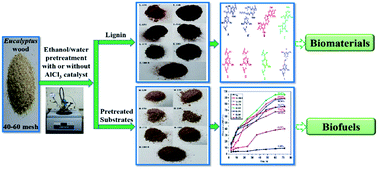A mild AlCl3-catalyzed ethanol pretreatment and its effects on the structural changes of Eucalyptus wood lignin and the saccharification efficiency†
Abstract
Ethanol organosolv pretreatment of biomass has been deemed as a green and environmentally friendly process. Lewis acid is regarded as a highly efficient catalyst in the pretreatment and conversion of biomass. In this work, Eucalyptus wood was pretreated by an ethanol/water solution (EWS) with or without aluminium chloride (AlCl3) catalyst, and the effects of the catalyst and pretreatment temperature on the structural characteristics of lignin, as well as the enzymatic hydrolysis of the substrates, have been thoroughly investigated. The comprehensive results showed that the lignins collected during the EWS pretreatment with AlCl3 catalyst exhibited smaller molecular weights (Mw), less β-O-4 linkages and more phenolic hydroxyl content, compared to those without AlCl3 catalyst. Additionally, GPC and NMR results revealed that the structural characteristics of the lignin obtained at 130 °C with AlCl3 were similar to those of lignin achieved at 180 °C without AlCl3 catalyst. Moreover, EWS pretreatment with AlCl3 catalyst improved the delignification ratio, degradation of hemicelluloses, and generated a higher crystallinity and surface area of the pretreated substrates compared to without the AlCl3 catalyst. Furthermore, the relatively mild pretreatment process (160 °C, 60 min) remarkably enhanced the enzymatic hydrolysis of substrates to a maximum value of 95.02%. Therefore, the EWS pretreatment with AlCl3 catalyst is an environmentally benign and advantageous scheme for the production of lignin with low Mw and high chemical reactivity, and more easily digestible substrates, which will be further transformed into value-added biomaterials and bioethanol.


 Please wait while we load your content...
Please wait while we load your content...